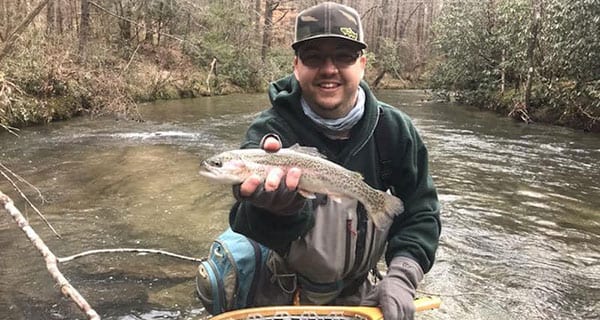Back in December, a friend of mine asked me if I knew what he was getting for Christmas; I replied, “No, I don’t have a clue.” That was not entirely true however, I guess I may have told a little fib, as I actually did know at least one thing he was going to be getting- a new fly rod. My friend tends to buy most of his toys from my shop, either in the form of new knives or fly fishing gear. For that reason, it was not a strange question for him to ask about his Christmas present because there was a good chance that someone buying gifts for him would have gotten it from my shop. As it turns out, he contacted me shortly after Christmas and said that I needed to take him fishing now so he could try out it his new fly rod. When you are itching to play with a new outdoor toy, you will sometimes decide to do so in conditions that you normally wouldn’t be choosing to go out in. In this case, a cold weekend day in January to fly fish for trout in an Upstate SC trout stream. We knew that the water would be high from all the recent rains, and that we would possibly have to work around other anglers, being that it was the weekend. But it seems you deal with less than ideal conditions when you want to try out a new rod.
We headed out early in hopes of getting to the water before anyone else. As we approached the parking area and saw no other vehicles, we figured that part of our goal was at least accomplished. We took a few minutes putting on our waders and boots and then rigged up our fly rods for the hike in. About a 10 minute walk through the woods got us to our destination. The river looked about as we expected, higher than usual water flow, but still relatively clear in color. Neither one of us had ever fished downstream very far from this access point so we decided to walk for a few minutes downstream to scout out some unfamiliar water. Fish in this river in the month of January can be rather few and far between so we thought maybe we could at least scout out some new water at very least.
With the fish being scarce to begin with, the higher water really makes them difficult to pin down. Our best bet to cover water and try to find one was to throw streamer pattern flies. If we found any fish by this method, we could switch to drifting nymphs in the current to catch them if they were not willing to take the streamer. As we settled into the water to fish our first section, I moved slightly upstream to fish the head of the run. My friend started about 20 yards below me, working the tail of the run. After 10 or so casts that were unproductive, we were about to make our way upstream to keep fishing but I wanted to show my friend the best technique for using the streamer fly he had tied on. I asked to borrow his rod for a second and proceeded to show him how to cast the fly as close to the opposite bank as possible, at about a 45 degree angle downstream of our position. As soon as the fly hits the water, hold the rod straight out in front of you, reaching and pointing the tip at the opposite bank. This allows the fly to swing across the strike zone and remain there in the current for a longer period of time. No sooner had I gotten the words out of my mouth of what I was doing, I saw a flash in the river near the fly and then felt the tug. “Oh, that’s a fish,” I exclaimed as I quickly handed the rod back to my friend. “No way am I going to be the one that catches the first fish on your new rod!” As it turns out, the fish came off the hook during the exchange, but we were redeemed about 2 casts later when my friend hooked and landed his first trout on his new fly rod. For the next few hours we were fortunate to pick up about ten more fish. It was encouraging to find a fish at just about every spot in the river we felt would hold one, however after only one fish in each spot, we had to move on. The name of the game in high water in January in a South Carolina trout stream is: Cover water with streamers and keep moving.
Brandon Barber is the owner of RiverBlade Knife & Fly Shop in Spartanburg, South Carolina.
